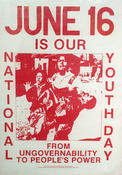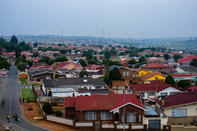International News

The name Soweto, along with words like apartheid, Sharpeville, Biko and Mandela, is instantly recognized in most parts of the world. Soweto is a city with no highrises, no downtown area, no luxurious shopping malls, no elegant parks, only one highway and scanty public facilities.
Yet, with the possible exceptions of Johannesburg and Cape Town, people around the world are more likely to recognize this name than that of any other South African city. Why is this so? Certainly, its size makes it noteworthy — it is believed that upwards of two million black people live there.
(By contrast, the nearby area of greater Johannesburg houses about 1,5 million people in an area five times that of Soweto.) But in Soweto's fame or notoriety around the world, a factor far more important than its size is the events of June 16, 1976, when emotions boiled over in a froth of violence against the system in its many forms. Suddenly, Soweto was international news, just as Sharpeville had been some 16 years before.
This time, however, a far more sophisticated network of international media was at hand to take the bloody events into living rooms around the world. An uneasy peace was eventually restored, a lid held firmly on the pot, but inside the anger still simmered in the country.
Further outbreaks in Soweto occurred sporadically, again reaching a peak during the 1984/85 'unrest', as it is euphemistically called, which spilled over into black townships throughout the country.
Isolation of the Black Townships

During the uprisings, the Government eventually gagged the media - but up until then the journalists had a field day and South Africa in general, was portrayed as being in flames — an African Beirut. Yet again the lid was forced back into place and a seeming calm was restored. In fact, because of the isolation of the black townships, white South Africans saw and felt little of these violent eruptions.
These outbursts of anger and revolutionary zeal will inevitably erupt in the future and will be systematically quelled until an equitable and acceptable solution to the country's political and social problems is found. Soweto is not one of a kind in South Africa as virtually every city, town and village has its equivalent: a satellite settlement of black workers attached by an umbilicus of road and/or rail to its white neighbour.
As did all these dormitory 'townships', Soweto came into existence only to serve the labour needs of the white community to which it is attached. It has grown up alongside Johannesburg, swelled by urbanization of the rural poor and the forced removal of black people from 'white areas' by the post Second World War Government of South Africa.
Soweto exists in the form that it does on the basis of the despised Group Areas Act one of the cornerstones of white Nationalist dogma which dictates that the people of South Africa shall live in separate areas according to the colour of their skin.
Although Soweto was officially recognized only in 1963, when it finally got a name, its existence dates back to 1886 — the year in which gold was first discovered along the Witwatersrand ridge. This ridge now forms a metropolitan spine with Johannesburg as its throbbing heart, Soweto and its gloomy soul.
By David Bristow